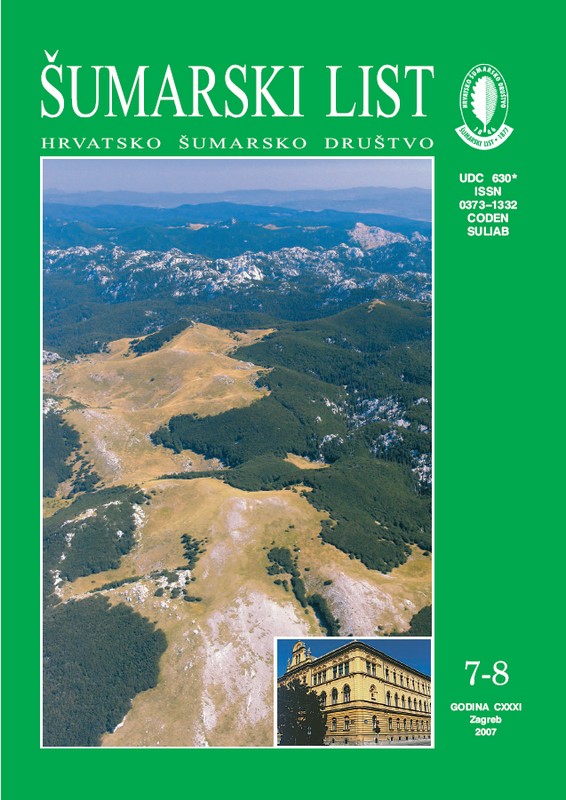
broj: 7-8/2007
pdf (21,1 MB) |
|
||||||||||||||
| IZVORNI ZNANSTVENI ČLANCI | ||
| Pernar, R., A. Seletković, M. Ančić | UDK 630* 429 + 453 (001) | |
| Assessing Forest Damage in the Spačva Basin with Colour Infrared Aerial Photographs pdf HR EN | 315 | |
| Degmečić, D., V. Jumić | UDK 630* 156 (001) | |
| Analysis of Morphometrical Characteristics of Antlers and Carcase Weight of Red Deer Stags (Cervus elaphus, L. 1758) in the State Hunting Ground Podunavlje – Podravlje XIV/9 Through Period 2001. – 2006. pdf HR EN | 333 | |
| STRUČNI ČLANCI | ||
| Prebježić, P. | UDK 630* 907 | |
| Graphical presentation of structural relations in a beech and fir stand (Abieti-Fagetum illyricum, Horv. 38) in the virgin forest of “Čorkova Uvala” in Plitvice Lakes National Park pdf HR EN | 345 | |
| Dražen Grgurević | UDK 630* 272 | |
| Palms in Adriatic Parks pdf HR EN | 353 | |
| Summary: Palms are favourite plants that originate from tropical and subtropical regions. They play a very important role in the diet, culture and civilisation of the peoples from these regions. Two shrub-like species – Chamaerops humilis L. and Phoenix theophrasti Greuter – are autochthonous to the Mediterranean. The majority of palm species are trees; however, rain forests of south-eastern Asia and Oceania are also home to climbing palms. There are no precise data on the period when palms were introduced in Europe. They were probably brought by the Romans after their conquests in the Near East, since they invariably brought back all portable spoils of war. Another possibility is the Phoenician colonisation of the Mediterranean, and yet another is Greek conquests. The first "imported" palm was probably a date palm due to its edible fruit. The great Flemish painter Jan van Eyck (1390–1441) paints a date palm with fruit in his famous landscape painting (polyptich). The first mention of a palm on the Adriatic coast was made by Father S. Razzi. The palm was in a monastery in Dubrovnik, where he lived for two years (1587–1589). Counting the age of the palm at the time of his record, the palm must have been planted in the mid sixteen century. Palms gradually spread along the Adriatic coast. The species Trachycorpus fortunei H. Wendl was planted in Opatija in the late 19th century thanks to its good tolerance of very low temperatures – up to 12 degrees C below zero. On the waterfront in Split, Morus alba L. was replaced with Phoenix canariensis - hort. ex Chabaud starting with 1921. This was the beginning of excessive and uncritical palm planting actions along the Croatian Adriatic coast. The action took such proportions that we may speak of the "palmisation" of the Adriatic coast. Apart from the above, the following species are also grown in the open along the Adriatic coast: Erythea armata S. Wats, Jubaea chilensis (Moll) Baile, Phoenix dactylifera L., Washingtonia filifera H, Wendl and W. robusta H. Wendl. Phoenix canariensis is the most widely spread plant. Unless growing in protected sites, palm trees freeze during severe winters. There was an exceptionally severe winter in 1962–1963. Before, palms were protected against winter in different ways. Today, palms are no longer protected due to global warming and palm acclimatisation. Several factors are responsible for the freezing of palms: soil, air humidity, exposure to wind and rain, and others. Palms in good condition have been noted to resist freezing. In our opinion, palms are a desirable floristic embellishment of Adriatic parks, on condition that proper measure is retained and that they are planted in carefully chosen positions in harmony with autochthonous vegetation. Although they are intended to preserve and improve the Adriatic landscape, this same landscape is endangered with overuse of exotic vegetation. | ||


